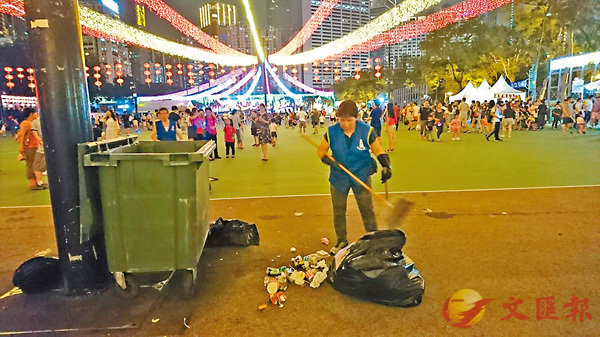 ■有清潔工人指市民在中秋節當晚遺留了大量食物、器皿等垃圾,需要他們清理,工作量較平日多。 資料圖片
■有清潔工人指市民在中秋節當晚遺留了大量食物、器皿等垃圾,需要他們清理,工作量較平日多。 資料圖片【原文】傳統的中秋節(Mid-Autumn festival)親友歡聚賞月,亦是產生大量垃圾的日子。
香港特區政府康樂及文化事務署(Leisure and Cultural Services Department)數字顯示,單在中秋節當晚,該署轄下場地包括沙灘及所有公園共收集了約55公噸(tonnes)的垃圾,較去年約54.36公噸稍增。
本港社會近年環保意識高漲,但每年重大節日的垃圾產生量卻不見下跌。要真正讓環保減廢見成效,一方面要市民大眾身體力行,另一方面需政府部門加強在大時大節期間的宣傳教育工作(campaign efforts),並且做好相關服務,方便應節物品循環再用或轉贈他人,還可以推動物品置換等新思維、新方法來促進環保減廢。
市民身體力行 政府加強教育
康文署一貫要求,市民在歡度中秋佳節時保持地方清潔及愛護公物,切勿煲蠟或放孔明燈(Kongming lanterns)。然而,一晚盡歡之後,有市民發現馬鞍山耀安邨樹木被掛上熒光棒,粉嶺蝴蝶山徑涼亭地上發現蠟跡,有郊外燒烤場(barbecue sites)滿佈垃圾,滿目瘡痍。
環保團體調查發現,2013年全港丟棄多達150萬個月餅(moon cakes)。這固然需要市民自我反省,意識到環保是要身體力行的,提升保護環境的自覺性;同時政府部門亦應當做足宣傳教育工作,尤其是大時大節前後的針對性宣傳。
政府可以探討與社會團體合作,建立機制方便市民將剩餘的應節物品轉送(regifting)他人或回收再造,變廢為寶。事實上,本港近年早有慈善團體呼籲市民,若有賣不完、送不完、食不完的月餅,切勿當垃圾拋棄,可送交慈善團體(charities),以便轉送獨居長者或有需要的市民。
相關計劃完全可以推廣開去,除了月餅,中秋節經常消費的燈籠,不少市民習慣年年換新,同樣可以推動回收共享,交換再用。
人均棄量新高 倡設交換平台
除了加強廢物分類回收工作,另一可以長期有效緩解香港垃圾問題的,還是要從源頭做起,減少廢物的產生。根據環保署數據,2015年港人人均棄置廢物量為每日1.39公斤,達到10年新高;與此同時,整體回收率(overall recovery rate)跌至35%,見5年新低。數字反映本港的環保減廢、回收再造情況不容樂觀。
其實,一件物品是垃圾還是有用的物件,很大程度上視乎當事人是否需要(personal needs),一個人的垃圾可能是另一個人的有用之物。無論內地或海外,都有現成的閒置物品交換平台,特區政府大可學習外地經驗,參考團體的月餅回收轉贈計劃,透過創新科技建立一套物品共享系統,方便市民透過系統進行物品置換。
如此一來,既可促成從源頭減廢,又可養成市民使用創新科技的習慣,未嘗不是值得探討的環保減廢新思維。 (標題及小標題為編輯所加) (摘錄自香港文匯報社評6-10-2017)
Festive garbage prompts review of waste policy
【譯文】The Mid-Autumn festival is when families gather-and produce tons of garbage. According to the Leisure and Cultural Services Department, on the single night of the festival this year, places managed by the department, including beaches and parks, received about 55 tonnes of waste, a little more than the 54.36 tonnes last year.
Hong Kong has seen an increasing awareness of environmental protection, but waste does not seem to decrease at prominent celebrations of the city. To change things, it's important that people do it, and the government accentuate their campaign efforts. Not just that, relevant services should be provided for ease of recycling or reuse, and, think about the concept of "bartering" and other news ways.
More action and education needed
The department, during the traditional Chinese festival associated with the moon and lanterns, always urge the public to keep places tidy and amenities neat, banning wax boiling and Kongming lanterns. But some still found left-over fluorescent sticks on trees in Yiu On Estate in Ma On Shan, and tracks in Wu Tip Shan in Fan Ling covered with wax. Refuse filled some country barbecue sites, witnesses also reported.
Environmental organizations have released solid data. In 2013 alone, Hong Kong trashed 1.5 million moon cakes. This is something alarming both for the public and the authorities.
The option of government-ngo coorperation is viable: a system that encourages regifting or recycling, giving waste a second life. In reality, many parties have suggested keeping unsold, ungifted and uneaten moon cakes for charities to distribute to elderly persons who live alone, and those in need. The project should radiate. Things other than moon cakes, for instance lanterns, which are ever renewed, can be collected, shared, reused.
Disposal rate record high
Another approach to reducing waste is from the sources. The Environmental Protection Department have revealed that the municipal solid waste disposal rate reached 1.39 kg per capita in 2015, a ten-year high; meanwhile overall recovery rate fell to a five-year low 35 per cent. The numbers do not seem optimistic.
An item's use value depends on personal needs, and we have seen "bartering" platforms blooming in the mainland China and overseas countries or regions. A similar platform driven with a creative outlook, where, for instance, the public can share superfluous moon cakes, is not hard to make real.
Such a system will cut waste from the sources, and edify fellow citizens to make most of innovative technology.■Jeffrey Tse [ywc_jeffrey@hotmail.com]
知多點
今年中秋節,康文署人員在轄下場地(泳灘及所有公園)共發出345個煲蠟的口頭警告、6個放孔明燈的口頭警告,去年中秋節則合共發出410個煲蠟的口頭警告、3個放孔明燈的口頭警告。兩年都沒有檢控個案。

